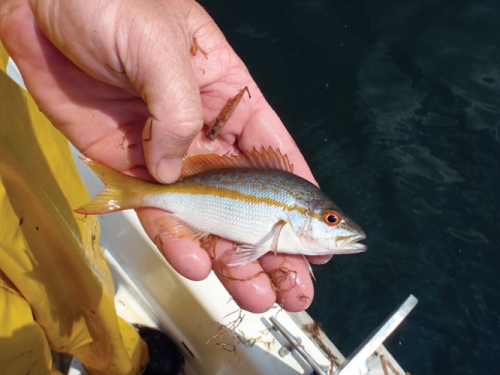Chris Baillie hauled the net onto the boat and dumped its contents in front of Joel Fodrie. They spread out the soaked seagrass and spotted an angry stingray, spindly spider crabs, grunting pigfish, and thousands of tiny pinfish, pipefish, puffer fish, starfish, stargazers, mojarra, anchovies, white perch, snapper, trout, and grouper. To Fodrie’s surprise, the fish looked fine. And his survey showed that there were millions of them, even in the wake of the worst oil spill in United States history. In fact, some species were more abundant than ever. But will this hold true over the long haul?
Fodrie has been studying seagrass habitats in the northern Gulf of Mexico since 2006, documenting the types of juvenile fish and their population levels each summer. When the BP oil spill happened in April 2010, he and others worried that billions of larvae that floated on ocean currents would be wiped out, devastating fisheries. “That didn’t happen,” Fodrie says. He checked fish populations in the seagrasses off the coasts of Louisiana, Mississippi, and Alabama in September 2010, and found higher numbers of fish for twelve of the twenty most abundant species than he’d found in the previous four years. He saw no increase or decrease in the other eight species.
“The spotted seatrout and gray snapper—there were millions of them,” he says. “Around ten times more than usual.” When Fodrie cut some trout open, he found shrimp. When he cut open snapper, he found shrimp, worms, crustaceans, and tiny fish. Everything looked normal. But that doesn’t mean that the oil didn’t harm any fish—even the species Fodrie studied—or that the future is definitely bright.
Fodrie says the oil may have killed off some unknown number of fish, but because the government shut down commercial fishing throughout the summer—and because some species are usually harvested before they spawn during the summer—there wound up being more juvenile fish present come autumn than in previous years.
What’s clear is that the oil spill damaged other habitats, such as salt marshes, oyster reefs, and the seafloor. Marine scientist Pete Peterson says thousands of animals, such as seabirds, sea turtles, and jellyfish, were seriously injured or killed. But the big unknown, he says, involves long-term consequences. Microbes have processed and transformed massive amounts of natural gas and oil. Those organisms make up the bottom rung of the food chain. It’s not clear what effect this might have on larger animals, including humans.
“The fish we studied got through the acute phase,” Fodrie says. “But oil pollution and oil dispersants can have chronic impacts. They can reduce long-term growth, reproduction, and survivorship rates.” For instance, if a fish stays smaller than usual due to oil toxicity, then it will produce fewer eggs. And that would mean fewer fish in the years ahead. “We just don’t know yet,” he says.
As the fish grow into adults, Fodrie will monitor various species, including species of red snapper, vermilion snapper, and mackerel whose larvae don’t wind up in seagrasses. As of last fall, fishers have been filling their nets with some fish species and shrimp, selling them to local restaurants.
“I had seafood twice last September at Dauphin Island, Alabama,” Fodrie says. “I know a couple of colleagues who ate cheap seafood all the time last fall. No regrets so far.”
Joel Fodrie is an assistant professor in the Institute of Marine Sciences. Chris Baillie graduated from UNC with a biology degree in 2010. Pete Peterson is a distinguished professor of marine sciences at UNC. ScienceNews covered Fodrie’s work here.


